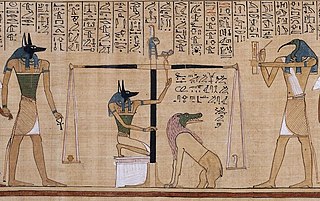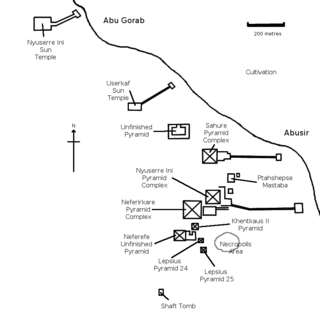
Papyrus is a material similar to thick paper that was used in ancient times as a writing surface. It was made from the pith of the papyrus plant, Cyperus papyrus, a wetland sedge. Papyrus can also refer to a document written on sheets of such material, joined side by side and rolled up into a scroll, an early form of a book.

Ammit was an ancient Egyptian goddess with the forequarters of a lion, the hindquarters of a hippopotamus, and the head of a crocodile—the three largest "man-eating" animals known to ancient Egyptians. In ancient Egyptian religion, Ammit played an important role during the funerary ritual, the Judgment of the Dead.

The Book of the Dead is an ancient Egyptian funerary text generally written on papyrus and used from the beginning of the New Kingdom to around 50 BC. The original Egyptian name for the text, transliterated r(ꜣ)w n(y)w prt m hrw(w), is translated as Book of Coming Forth by Day or Book of Emerging Forth into the Light. "Book" is the closest term to describe the loose collection of texts consisting of a number of magic spells intended to assist a dead person's journey through the Duat, or underworld, and into the afterlife and written by many priests over a period of about 1,000 years. Karl Richard Lepsius introduced for these texts the German name Todtenbuch, translated to English as Book of the Dead.

Canopic jars are containers that were used by the ancient Egyptians during the mummification process, to store and preserve the viscera of their owner for the afterlife. They were commonly either carved from limestone or made of pottery. These jars were used by the ancient Egyptians from the time of the Old Kingdom, until the time of the Late Period or the Ptolemaic Period, by which time the viscera were simply wrapped and placed with the body. The viscera were not kept in a single canopic jar: each jar was reserved for specific organs. The term canopic reflects the mistaken association by early Egyptologists with the Greek legend of Canopus – the boat captain of Menelaus on the voyage to Troy – "who was buried at Canopus in the Delta where he was worshipped in the form of a jar". In alternative versions, the name derives from the location Canopus in the western Nile Delta near Alexandria, where human-headed jars were worshipped as personifications of the god Osiris.

The Book of Abraham is a collection of writings claimed to be from several Egyptian scrolls discovered in the early 19th century during an archeological expedition by Antonio Lebolo. Members of the Church of Jesus Christ of Latter-day Saints purchased the scrolls from a traveling mummy exhibition on July 3, 1835, to be translated into English by Joseph Smith. According to Smith, the book was "a translation of some ancient records... purporting to be the writings of Abraham, while he was in Egypt, called the Book of Abraham, written by his own hand, upon papyrus". Smith said the papyri described Abraham's early life, his travels to Canaan and Egypt, and his vision of the cosmos and its creation.

The Elephantine Papyri and Ostraca consist of thousands of documents from the Egyptian border fortresses of Elephantine and Aswan, which yielded hundreds of papyri and ostraca in hieratic and demotic Egyptian, Aramaic, Koine Greek, Latin and Coptic, spanning a period of 100 years in the 5th to 4th centuries BCE. The documents include letters and legal contracts from family and other archives, and are thus an invaluable source of knowledge for scholars of varied disciplines such as epistolography, law, society, religion, language and onomastics. The Elephantine documents include letters and legal contracts from family and other archives: divorce documents, the manumission of slaves, and other business. The dry soil of Upper Egypt preserved the documents.

The Papyrus of Ani is a papyrus manuscript in the form of a scroll with cursive hieroglyphs and colour illustrations that was created c. 1250 BCE, during the Nineteenth Dynasty of the New Kingdom of ancient Egypt. Egyptians compiled an individualized book for certain people upon their death, called the Book of Going Forth by Day, more commonly known as the Book of the Dead, typically containing declarations and spells to help the deceased in their afterlife. The Papyrus of Ani is the manuscript compiled for the Theban scribe Ani; it is now in the British Museum.

Sir Ernest Alfred Thompson Wallis Budge was an English Egyptologist, Orientalist, and philologist who worked for the British Museum and published numerous works on the ancient Near East. He made numerous trips to Egypt and Anglo-Egyptian Sudan on behalf of the British Museum to buy antiquities, and helped it build its collection of cuneiform tablets, manuscripts, and papyri. He published many books on Egyptology, helping to bring the findings to larger audiences. In 1920, he was knighted for his service to Egyptology and the British Museum.

The Joseph Smith Papyri (JSP) are Egyptian funerary papyrus fragments from ancient Thebes dated between 300 and 100 BC which, along with four mummies, were once owned by Joseph Smith, the founder of the Latter Day Saint movement. Smith purchased the mummies and papyrus documents from a traveling exhibitor in Kirtland, Ohio in 1835. Smith said that the papyrus contained the records of the ancient patriarchs Abraham and Joseph.

A hypocephalus is a small disk-shaped object generally made of stuccoed linen, but also of papyrus, bronze, gold, wood, or clay, which ancient Egyptians from the Late Period onwards placed under the heads of their dead. The circle was believed to magically protect the deceased, cause the head and body to be enveloped in light and warmth, making the deceased divine. It replaced the earlier cow-amulet.

Gebelein was a town in Egypt. It is located on the Nile, about 40 km south of Thebes, in the New Valley Governorate.

The Abusir Papyri are the largest papyrus findings to date from the Old Kingdom in ancient Egypt. The first papyri were discovered in 1893 at Abu Gorab near Abusir in northern Egypt. Their origins are dated to around the 24th century BC during the Fifth dynasty of Egypt, making them, even though often badly fragmented, among some of the oldest surviving papyri to date. Later on, a large number of additional manuscript fragments were discovered in the area.

Insinger Papyrus is a papyrus find from ancient Egypt and contains one of the oldest extant writings about Egyptian wisdom teachings (Sebayt). The manuscript is dated to around the 1st century BC according to the Rijksmuseum van Oudheden in Leiden where the main part is kept. Other sources suggest it dates to the 1st century AD, and to the 3rd century BC. Fragments have also been found in other collections.

In Ancient Egyptian religion, Medjed is a minor deity mentioned in certain copies of the Book of the Dead. While not much is known about the deity, his ghost-like depiction in the Greenfield papyrus has earned him popularity in modern Japanese culture, and he has appeared as a character in video games and anime.

The Ptolemaic cult of Alexander the Great was an imperial cult in ancient Egypt during the Hellenistic period, promoted by the Ptolemaic dynasty. The core of the cult was the worship of the deified conqueror-king Alexander the Great, which eventually formed the basis for the ruler cult of the Ptolemies themselves. The head priest of the imperial cult was the chief priest in the Ptolemaic Kingdom.

Ancient Egyptian afterlife beliefs were centered around a variety of complex rituals that were influenced by many aspects of Egyptian culture. Religion was a major contributor, since it was an important social practice that bound all Egyptians together. For instance, many of the Egyptian gods played roles in guiding the souls of the dead through the afterlife. With the evolution of writing, religious ideals were recorded and quickly spread throughout the Egyptian community. The solidification and commencement of these doctrines were formed in the creation of afterlife texts which illustrated and explained what the dead would need to know in order to complete the journey safely.

The Cavern deities of the underworld were ancient Egyptian minor deities charged with punishing the damned souls by beheading and devouring them.

The Assessors of Maat were 42 minor ancient Egyptian deities of the Maat charged with judging the souls of the dead in the afterlife by joining the judgment of Osiris in the Weighing of the Heart.

Papyrus 121 is a Greek magical manuscript written in papyrus from the 3rd century CE. This is one of that are called Greek Magical Papyri. The papyri had been brought from Egypt by Ernest Alfred Thompson Wallis Budge.


















